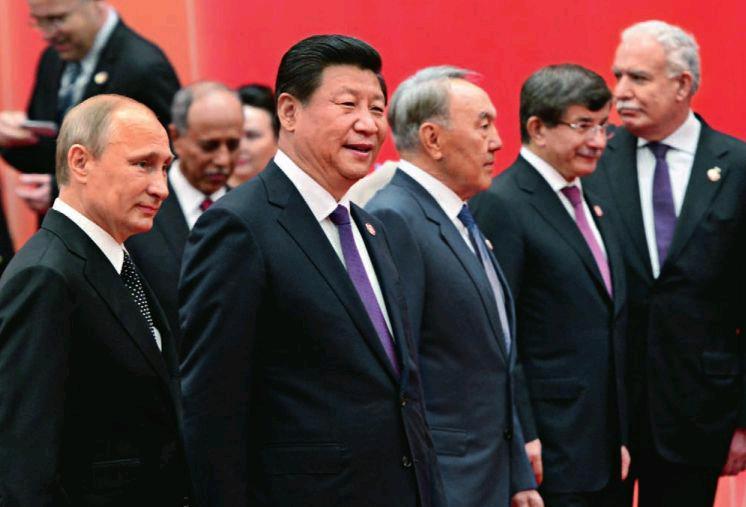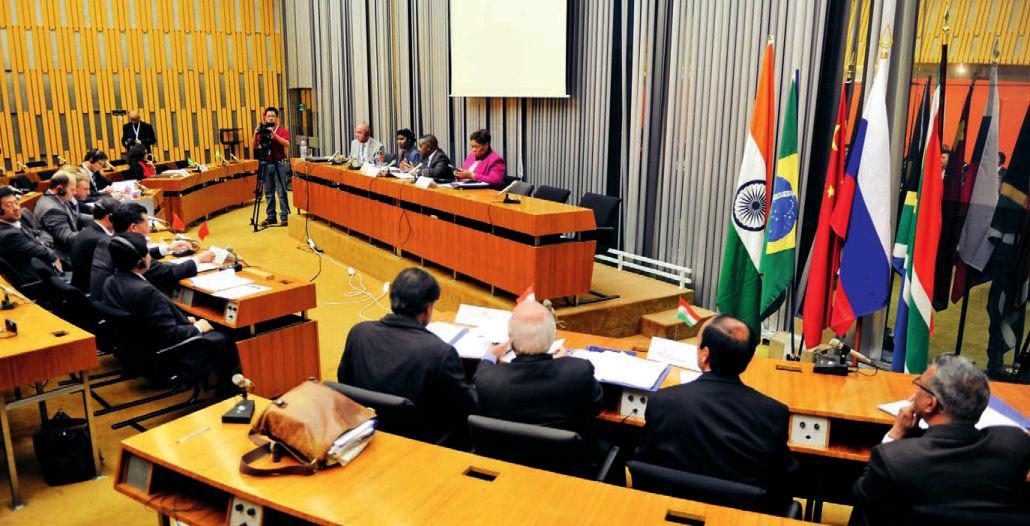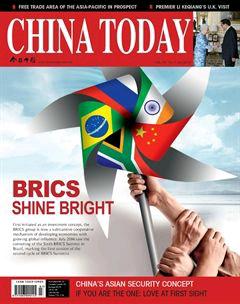Platform for Emerging Powers
By+SHEN+YI
THERE is a Chinese saying,“Many things grow in the garden that were never sown there.” Jim ONeill, chief economist of Goldman Sachs Asset Management, first coined the BRIC acronym in 2001 to highlight the economic potential of Brazil, Russia, India, and China. In October 2003, Goldman Sachs released its annual report themed Dreaming with BRICs: the Path to 2050. The companys main aim in creating this catchy term was to market its financial products. But ONeill and Goldman Sachs unwit- tingly made history by giving prominence to a significant post-Cold War transition in the international system– that of the rise of a group of emerging countries. Their potential largely ignored, courtesy of the BRICs concept this group of nations assumed the ethos of a cohesive force whose farreaching effects were way beyond the expectations of Goldman Sachs.
When leaders of the BRIC countries first met in Russia in June 2009, they released a joint statement, so signifying the right of the BRIC nations to speak as a group. Leaders of the four countries again issued a joint statement at the second BRIC Summit in April 2010 in Brazil. They moreover discussed major issues on the international agenda and concrete steps towards BRIC cooperation and coordination. A cooperation mechanism of BRIC nations thus took shape. The BRIC connotation was that of a unified voice of emerging economies, as represented by BRIC, in all aspects of global affairs.
Developed Country Angst
At this time there arose a worldwide debate over BRIC prospects. It forced Goldman Sachs to consider an alternative term. Some held that the BRIC nations should be regarded strictly as an economic concept that excludes countries unable to achieve a certain level of economic growth. Meanwhile, differences among BRIC nations continued to loom large. The debate, seen from an extreme perspective, echoed those between the opposing Cold War camps over development paths and patterns. Widespread underestimation of BRIC countries and the assumption that they were bound to dissolve embody the frustration-induced aggression engendered by Western angst, apparent in the media, over emerging developing economies as represented by the BRIC nations.
Such anxiety reflected deep Western concern over the shifting power dynamic within the world system. International Monetary Fund (IMF) data show that, calculated according to nominal value, in 1992 the GDP of developed countries accounted for 83.6 percent of the global economy, of which the U.S. contributed 26 percent. The GDP of developing and transitional countries, meanwhile, was only 16.4 percent, of which BRICS(Brazil, Russia, India, Russia, and South Africa) contributed 5.7 percent. Twenty years later in 2012, the global economic pattern had changed dramatically. The GDP of developed countries had fallen to 61.9 percent of the global economy, that of the U.S. accounting for 21.9 percent. The GDP of non-Western countries, however, rose to 38.1 percent, that from BRICS having risen to 20.7 percent.
If calculated according to purchasing power parity, from 1992 to 2012 the proportion in the world economy of developed countries economic aggregate fell from 64.3 percent to 49.8 percent, while that of non-Western countries rose from 35.9 percent to 49.9 percent, for the first time surpassing the developed Western world. The share of the Group of Sevens economic aggregate, meanwhile, dropped from 51.4 percent to 37.8 percent, and that of the U.S. from 22.8 percent to 18.9 percent. The BRICS countries economic aggregate during this period rose from 15.3 percent to 27.2 percent.
These changes imply a transition of economic power. Developing countries having hitherto lacked a unified concept, it was clear that their uniting and reaching consensus on a new system of global governance would pose unprecedented challenges to the scheme long since established by Western countries – one whose impact could surpass that of the Cold War.
Opinions on Global Issues
Under the background of changing economic strength, BRICS understanding of its function also underwent significant change, manifest in the two ChinaRussia joint statements released in 2013 and 2014.
In the China-Russia Joint Statement announced on March 23, 2013, the two countries pledged to raise BRICS cooperation at the upcoming fifth summit in Durban on March 27 to a new level. The two sides supported the idea of BRICSgradually becoming a dialogue and cooperation mechanism in world major economic and political issues. It is this function, rather than the notion of a loosely connected group of countries with rapid economic development, that clearly defines BRICS. These nations have come to the realization that they must express opinions on extensive global issues, pin-pointing common interests and concerns through which to promote cooperation.
China and Russia issued a joint statement on May 20, 2014 at the recently concluded Fourth Summit of the Conference on Interaction and Confidence Building Measures in Asia (CICA). In it, both sides advocate partnership diplomacy within a net structure to establish a flexible mechanism in international affairs, of which G20, BRICS and the Shanghai Cooperation Organization are working models. The BRICS concept has thus developed from a dialogue mechanism to a diplomacy mechanism.
The joint statement further points out that the primary mission of the BRICS group is to develop cooperation in various fields and to play an important role in the global economic governance mechanism. To be specific, BRICS should become the mechanism for extensive cooperation and coordination – in global economy and finance as well as international politics. This should include closer economic partnerships within the BRICS framework and the building of a development bank and contingency reserve pool. As part of the global economic governance mechanism, BRICS countries should jointly demand the right to speak for and represent emerging markets and developing countries, and build an open world economy. In foreign policy, BRICS countries should deepen cooperation in such areas as mediating regional conflicts, nonproliferation of weapons of mass destruction, combating international terrorism and drug trafficking, safeguarding international information security, maintaining outer space security, and guaranteeing human rights. As a concentrated expression of rising emerging countries, BRICS should represent developing nations in global economy and politics, and improve the status of emerging markets and developing countries. This constitutes the deep transformation and rise of BRICS.
New Order
BRICS countries thus started and gradually completed their transformation from the Goldman Sachs “BRIC”concept to a representative and flexible platform for emerging powers – one that is rapidly ascending to an important global position. China and Russia are interested in building a new-type rela- tionship between great powers; India, Brazil and South Africa aspire to prove their functions and influence in regional and global affairs. These countries are aware of the special significance and value of BRICS. The BRICS development tendencies might be defined as comprehensively expanding cooperation by forming a network platform extensively participated in by emerging markets and developing countries, and promoting development of network partnerships.
At the upcoming BRICS summit in Brazil, the substantive cooperation among these countries will enter a new stage, involving stable banking and finance, information infrastructure construction, and higher education. This will prefigure a new pattern of relationship between great powers, evident in the frequently mentioned “new political and economic world order.”

